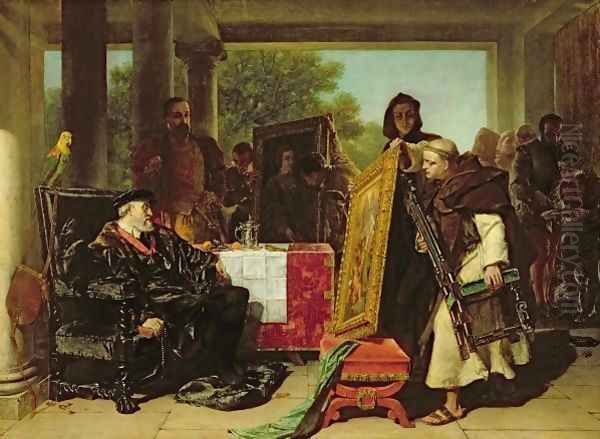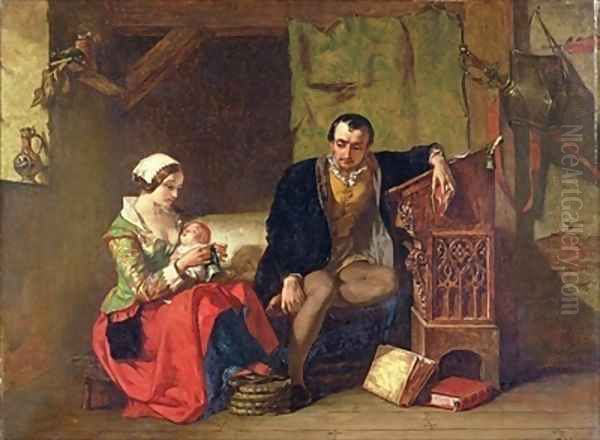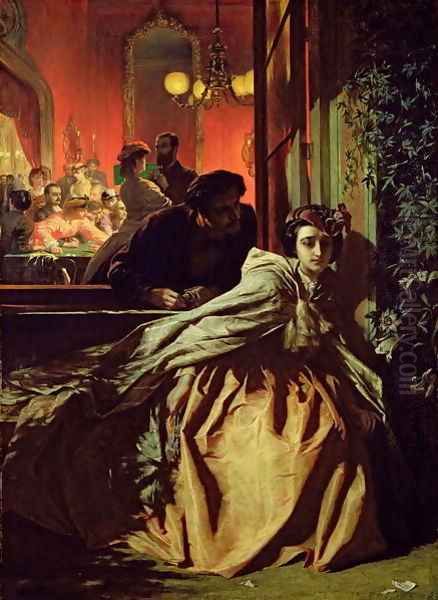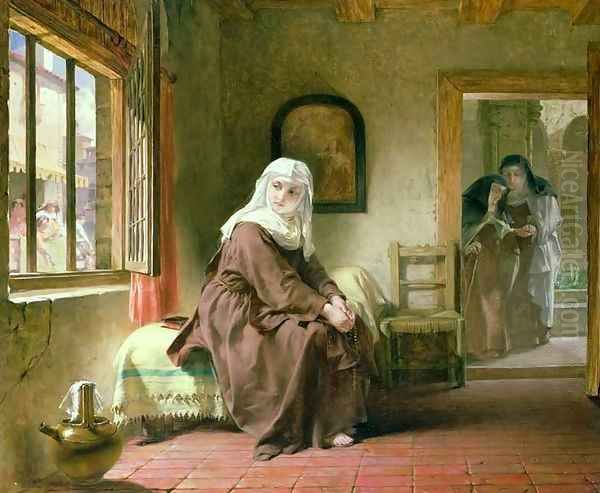Alfred Elmore RA (1815-1881) stands as a significant, if sometimes overlooked, figure in the landscape of 19th-century British art. An artist of Irish birth who made his career in London, Elmore was a painter of considerable talent and versatility, adept at capturing dramatic historical narratives, poignant genre scenes, and insightful literary interpretations. His journey through the Royal Academy, his association with influential artistic circles, and his engagement with the pressing social and intellectual currents of his time all contributed to a body of work that offers a fascinating window into the Victorian era. This exploration will delve into his life, his artistic development, his key works, and his enduring, though perhaps under-appreciated, legacy.
Early Life and Artistic Awakening
Alfred Elmore was born in Clonakilty, County Cork, Ireland, in 1815. His father, Dr. John Richard Elmore, was a surgeon who had retired from the British Army. The Elmore family was not one of landed gentry, but they possessed a degree of social standing and intellectual curiosity that would have fostered a stimulating environment for a young, artistically inclined mind. The Ireland of Elmore's early childhood was a land of complex social and political dynamics, still grappling with the aftermath of the Act of Union and the ongoing struggles for Catholic emancipation. While it's unclear how directly these early years in Ireland shaped his later artistic preoccupations, the experience of a different cultural milieu may have subtly informed his perspective.
Around the age of twelve, in 1827, the Elmore family relocated to London. This move was pivotal, placing young Alfred at the heart of the British Empire and its burgeoning art world. London in the late 1820s and 1830s was a city of immense energy, undergoing rapid industrialization and social change. For an aspiring artist, it offered unparalleled opportunities for study and exposure to both historical masterpieces and contemporary artistic innovation.

Elmore demonstrated an early aptitude for drawing, and his talents were recognized and encouraged. He embarked on a formal artistic education, a crucial step for any ambitious young painter of the period. His initial training likely involved tutelage under a practicing artist or at one of the smaller private art schools that proliferated in London. The core of academic art training at this time emphasized rigorous study of anatomy, perspective, and, above all, drawing from the antique – classical sculptures that were considered the epitome of ideal form and proportion.
The Royal Academy Schools and Early Exhibitions
The most prestigious institution for artistic training in Britain was, undoubtedly, the Royal Academy Schools. Elmore gained admission to these esteemed schools in 1832, at the age of seventeen. Entry was competitive, requiring applicants to submit proficient drawings as evidence of their skill. Once admitted, students like Elmore received free instruction from established Royal Academicians. The curriculum was demanding, focusing on life drawing, copying Old Masters, and attending lectures on anatomy, perspective, and art theory. Artists such as Sir Thomas Lawrence, who was President of the Royal Academy until his death in 1830, and his successor Sir Martin Archer Shee, would have embodied the academic ideals of the institution.
Elmore was a diligent student, and his progress was steady. He began exhibiting his work publicly while still a student, a common practice for aspiring artists seeking to gain recognition and attract patrons. His first work to be shown at the Royal Academy of Arts was in 1834. This marked the beginning of a long and consistent exhibiting career at the Academy, which would span nearly five decades. Early works would have likely included portraits, small genre scenes, or historical subjects that aligned with academic expectations. He also exhibited at other venues, such as the British Institution and the Society of British Artists.
During these formative years, Elmore would have been keenly aware of the dominant artistic trends. The grand historical narratives of painters like Benjamin Robert Haydon, though often commercially unsuccessful, were still considered the highest form of art. Genre painting, popularized by the immensely successful Scottish artist Sir David Wilkie, was gaining increasing favor for its relatable scenes of everyday life. The legacy of William Hogarth, with his satirical and moralizing narratives, also continued to resonate. These diverse influences would all play a part in shaping Elmore's artistic trajectory.
The Clique: A Fraternity of Young Ambition

In the late 1830s, Elmore became associated with a group of young, like-minded artists known as "The Clique." Founded around 1837 by the brilliant but tragically fated Richard Dadd, The Clique was an informal sketching society rather than a movement with a rigid manifesto. Its members, who included Augustus Egg, William Powell Frith (who would later achieve immense fame with paintings like Derby Day), Henry Nelson O'Neil, and John Phillip (later known as "Phillip of Spain" for his Spanish subjects), met regularly to sketch subjects chosen by the host and to discuss art.
The Clique shared a certain rebellious spirit, a reaction against what they perceived as the staid traditionalism of the Royal Academy's older guard. While they were all products of the Academy system and aspired to success within it, they sought fresh approaches to subject matter and narrative. They consciously looked back to earlier British artists, particularly William Hogarth, for inspiration, admiring his ability to tell compelling stories with a moral or social dimension. They also revered Sir David Wilkie for his skill in depicting character and everyday life.
The subjects chosen by The Clique often leaned towards literary themes, particularly from Shakespeare and other popular authors, as well as historical incidents and genre scenes with a strong narrative or anecdotal quality. Their approach was generally more illustrative and less concerned with the lofty idealism of "High Art" than with engaging the viewer directly through storytelling. Elmore's involvement with The Clique was significant; it provided him with a supportive network of peers, a forum for exchanging ideas, and a shared sense of purpose during a crucial stage of his development. His early works often reflect the group's preoccupations, featuring scenes from literature, history, and contemporary life, rendered with a focus on clear narration and characterization.
European Travels: Broadening Horizons
A crucial element in the education of many 19th-century artists was the Grand Tour, or at least an extended period of travel and study on the Continent. From 1840 to 1844, Elmore embarked on such a journey, visiting several major artistic centers in Europe. This period of immersion in the art of the past was transformative for many artists, and Elmore was no exception.

His itinerary included Paris, where he would have encountered the work of French Romantic painters like Eugène Delacroix and the rising stars of the French academic tradition. He then traveled to Italy, the cradle of the Renaissance and a repository of classical antiquity. In Venice, he would have studied the rich colors and dramatic compositions of Titian, Veronese, and Tintoretto. Florence would have offered the masterpieces of Leonardo da Vinci, Michelangelo, and Raphael, as well as the pioneers of the Early Renaissance. Rome, with its ancient ruins and the Vatican's treasures, was an essential stop, providing unparalleled exposure to classical sculpture and High Renaissance painting.
Elmore also visited Munich, which had become a significant art center under King Ludwig I, known for its neoclassical architecture and the Nazarene-influenced frescoes commissioned for public buildings. Dresden, with its renowned Gemäldegalerie Alte Meister, would have provided further opportunities to study Old Masters from across Europe.
This extensive tour allowed Elmore to see firsthand the works he had previously known only through prints or copies. It deepened his understanding of composition, color, and technique, and broadened his iconographic vocabulary. The experience undoubtedly enriched his artistic practice, providing him with a wealth of visual material and a more profound connection to the historical traditions of European art. Upon his return to London in 1844, he was a more mature and technically accomplished artist.
Gaining Recognition: Associateship and Full Membership of the RA
The year of his return, 1844, proved to be a turning point for Elmore. He exhibited Rienzi in the Forum, a historical painting depicting the 14th-century Roman populist leader. The subject, drawn from Edward Bulwer-Lytton's popular novel Rienzi, the Last of the Roman Tribunes (1835), was one that resonated with Victorian audiences interested in themes of liberty, power, and historical romance. The painting was well-received and, significantly, led to his election as an Associate of the Royal Academy (ARA) in the same year. This was a major step in his career, conferring prestige and placing him on the path to full membership.
Over the following decade, Elmore continued to produce a steady stream of historical and genre paintings, often drawing on literary sources or dramatic historical episodes. His works were characterized by competent draughtsmanship, careful attention to historical detail (a hallmark of Victorian historical painting), and a clear narrative structure. He tackled subjects from Shakespeare, such as The Taming of the Shrew, and explored episodes from religious history and the lives of historical figures.

One of his most acclaimed works from this period was The Emperor Charles V at the Convent of Yuste, exhibited in 1856. This painting depicted the abdicated Holy Roman Emperor in his monastic retirement, a subject that allowed for a blend of historical grandeur and introspective melancholy. The work was praised for its technical skill and its sensitive portrayal of the aged monarch. The success of such paintings solidified Elmore's reputation, and in 1857, he was elected a full Royal Academician (RA), the highest honor for a British artist. This achievement marked his full acceptance into the art establishment.
Elmore's style during this period, while rooted in academic principles, also showed an awareness of contemporary trends. He was a contemporary of the Pre-Raphaelite Brotherhood (PRB), whose members like John Everett Millais, William Holman Hunt, and Dante Gabriel Rossetti were challenging academic conventions with their bright colors, meticulous detail, and often unconventional compositions. While Elmore was not a Pre-Raphaelite, he, like many artists of his generation, likely absorbed some of their emphasis on truth to nature and intensity of expression, even if his overall approach remained more traditional.
On the Brink: A Moral Tale for the Victorian Age
Perhaps Alfred Elmore's most famous and enduring work is On the Brink, painted in 1865 and now housed in the Fitzwilliam Museum, Cambridge. This painting is a quintessential example of Victorian narrative art, imbued with moral sentiment and social commentary. The scene is set in a gambling salon, likely in a fashionable Continental spa town like Homburg or Baden-Baden, which were notorious for their casinos.
The central figure is a young woman, elegantly dressed but with an expression of despair and desperation. She stands at a gaming table, having evidently lost her money, and perhaps more. Her gloved hand clutches a few remaining chips, while her other hand rests on the back of a chair, as if for support. Her gaze is fixed on the unseen roulette wheel or card game, a mixture of hope and dread in her eyes. To her right, a shadowy male figure, possibly a seducer or a creditor, leans in, his intentions ambiguous but suggestive of further peril. In the background, the opulent yet morally dubious world of the casino continues, indifferent to her plight.

On the Brink tapped into several Victorian anxieties: the dangers of gambling, the vulnerability of women, the loss of fortune and reputation, and the moral temptations of modern life. The "fallen woman" was a common trope in Victorian art and literature, and Elmore's painting can be seen as a variation on this theme, though here the fall is precipitated by financial ruin and its potential social consequences rather than explicitly sexual transgression. The painting’s title itself is evocative, suggesting a precipice of social, moral, or financial ruin.
The work was widely discussed and reproduced as an engraving, making it accessible to a broad public. Its power lies in its psychological intensity and its ability to tell a compelling story with a strong emotional impact. The careful rendering of details – the fashionable attire, the opulent setting, the expressive faces – all contribute to the painting's effectiveness as a piece of social drama. It is a work that invites contemplation on themes of temptation, consequence, and the fragility of social standing, themes that resonated deeply with the Victorian conscience. The painting's narrative clarity and emotional charge are reminiscent of the works of contemporary novelists like Charles Dickens or Wilkie Collins, who also explored the moral complexities of modern urban life.
Later Career: Evolving Styles and Enduring Themes
In the later stages of his career, from the late 1860s onwards, Elmore's style showed some evolution. While he continued to produce historical and genre scenes, there was a discernible shift towards a more classical or academic aesthetic, possibly influenced by the work of artists like Lord Frederic Leighton and Sir Edward Poynter, who were champions of a revived classicism in British art. There was also an increasing interest in Orientalist themes, a popular trend in Victorian art fueled by colonial expansion, travel, and a fascination with the "exotic" cultures of the Middle East and North Africa. Artists like John Frederick Lewis and the French painter Jean-Léon Gérôme had already established Orientalism as a significant genre.
One notable work from this later period is Pompeii, A.D. 79, exhibited at the Royal Academy in 1878. This painting depicts an interior scene in the Roman city just before its destruction by the eruption of Mount Vesuvius. Unlike the more cataclysmic visions of the event, such as Karl Bryullov's famous The Last Day of Pompeii (1830-33), Elmore's painting focuses on a moment of domestic unease or perhaps quiet foreboding. The subject of Pompeii was perennially popular, offering opportunities for archaeological accuracy, classical settings, and human drama. Elmore's treatment reflects his continued interest in historical narrative, rendered with a polished technique.
His engagement with Orientalist subjects can be seen in paintings that depict scenes from the Middle East or feature figures in "oriental" costume. This was part of a broader cultural phenomenon, but for Elmore, it also represented an expansion of his thematic repertoire and an opportunity to explore different palettes and compositional strategies.
Throughout his career, Elmore was known for his professionalism and his consistent output. The Art Journal, a leading art periodical of the time, commented on the surprisingly large number of works he exhibited at the Royal Academy, calling it "an exception in the history of the Academy." This suggests a dedicated and prolific artist. The same journal also praised his potential, stating that if he continued to progress, he would soon be ranked among Britain's great masters. While that prediction might be seen as overly optimistic in retrospect, it indicates the high regard in which he was held by some of his contemporaries.
The Origin of the Stocking Loom and Social Commentary
Another significant work by Elmore is The Origin of the Stocking Loom, now in the collection of Nottingham City Museums and Art Gallery. The painting depicts the apocryphal story of William Lee, the supposed inventor of the stocking frame knitting machine in the late 16th century. According to legend, Lee, a clergyman, was spurned by a woman who was more interested in her hand-knitting than in him. Frustrated, he vowed to invent a machine that would supersede her craft. Elmore’s painting captures a moment of inspiration or perhaps contemplation related to this endeavor.
The choice of subject is interesting. By the 19th century, the stocking loom had become a symbol of industrialization in the textile industry, particularly in the Midlands region around Nottingham. This area was also the heartland of the Luddite movement in the early 19th century, where workers, fearing for their livelihoods, smashed mechanized looms. While Elmore's painting ostensibly depicts a historical moment of invention, its placement in Nottingham and its subject matter inevitably evoke the complex legacy of mechanization and its impact on workers.
It is plausible that Elmore, through this painting, was reflecting on the themes of technological innovation, its human cost, and the societal changes wrought by the Industrial Revolution. While not an overtly political painting, it touches upon issues that were central to Victorian society. The work demonstrates Elmore's ability to engage with subjects that had contemporary resonance, even when framed within a historical context. His connection to "The Clique," with its Hogarthian interest in social observation, may have laid the groundwork for this kind of thematic exploration.
Elmore's Artistic Circle and Influences
Beyond The Clique, Elmore operated within a broader artistic and social milieu. As a Royal Academician, he would have known most of the leading artists of his day. His contemporaries at the Academy included figures like Daniel Maclise, a fellow Irishman known for his large-scale historical frescoes in the Houses of Parliament; William Mulready, another Irish-born artist celebrated for his meticulously crafted genre scenes; and Charles Robert Leslie, known for his paintings from literature and history.
The artistic landscape of Victorian Britain was diverse and dynamic. Elmore's career spanned the rise and fall of various movements and styles. He witnessed the dominance of narrative painting, the challenge of Pre-Raphaelitism, the revival of classicism, the emergence of Aestheticism, and the growing influence of French art. While he remained largely within the tradition of narrative and historical painting, his work reflects an awareness of these shifting currents. His later adoption of a more classical style and his foray into Orientalism show his responsiveness to prevailing artistic fashions.
The influence of earlier masters remained a constant. His European travels would have instilled a deep appreciation for the Venetian colorists, the Roman High Renaissance, and Dutch Golden Age painters like Rembrandt and Vermeer for their mastery of light and character. These historical influences, filtered through the lens of academic training and contemporary Victorian taste, shaped his artistic vision.
Legacy and Critical Reassessment
Alfred Elmore died in London on January 24, 1881. He left behind a substantial body of work that contributed to the rich tapestry of Victorian art. In his time, he was a respected and successful artist, a full member of the Royal Academy, and a painter whose works were known to a wide public through exhibitions and engravings.
However, like many Victorian academic painters, Elmore's reputation declined in the early 20th century with the rise of Modernism. The narrative and anecdotal qualities that had appealed to Victorian audiences were often dismissed by modernist critics as sentimental or overly literary. Historical painting, once considered the pinnacle of artistic achievement, fell out of favor.
In more recent decades, there has been a significant reassessment of Victorian art. Art historians and curators have begun to look beyond modernist prejudices and to appreciate 19th-century academic painting on its own terms. Artists like Elmore are now recognized for their technical skill, their narrative abilities, and their role in reflecting and shaping the cultural values of their time.
While Elmore may not be as widely known today as some of his contemporaries like Millais, Frith, or Leighton, his work remains important for understanding the scope and diversity of Victorian art. Paintings like On the Brink continue to engage viewers with their dramatic storytelling and psychological insight. His historical scenes provide valuable glimpses into how the Victorians envisioned the past, and works like The Origin of the Stocking Loom touch upon the profound societal transformations of the era.
Alfred Elmore was a dedicated craftsman and a thoughtful interpreter of human experience. He navigated the complex art world of Victorian Britain with skill and perseverance, creating a body of work that, while perhaps not consistently groundbreaking, is consistently intelligent, well-executed, and reflective of the era in which he lived. His paintings offer enduring narratives that speak to both the specific concerns of the 19th century and the more universal aspects of history, morality, and the human condition. As the study of Victorian art continues to flourish, Alfred Elmore's contributions are likely to receive further well-deserved attention.